一起聊聊Java常用資料型別的輸入輸出
本篇文章為大家帶來了關於java的相關知識,其中主要介紹了常用資料類型的輸入輸出相關問題,下面我們就透過範例來看一下怎麼搞定這些常用資料型態輸入輸出的問題,希望對大家有幫助。

推薦學習:《java教學》
#C語言學習到Java後,第一個感覺就是Java的寫法很複雜,同時,在常用的資料類型的輸入輸出上也沒有C語言那麼方便。在C語言上面,用 scanf 函數可以很方便的輸入大多數格式,在Java上卻不行,Java當中沒有類似scanf的語句。
本文搭配本人的輸入輸出習慣及做題的記錄,對這些不同類型的如整型的,是整型的但隔開參數的...做一個總結。以下的說明中主類均為Main類,我們使用Scanner來進行輸入。每一種輸入或輸出可能有多種方法,本人只寫了較簡單的寫法。
1、Char型
這裡所說的char型指的是只輸入一個字元的情況。
1.1 輸入格式:
#import<span style="background-color:#ed7976;">java.io.IOException</span>;//匯入包
publicclassMain {<!-- -->##
publicstaticvoidmain(String[] args) <span style="background-color:#ed7976;"></span>throws<span style="background-color:#ed7976;"></span>##IOException<!-- --> {
<strong> <span style="color:#0d0016;"></span>char</strong>
# #ch = (char)System.in.read();//<1>
## System.out.println((
int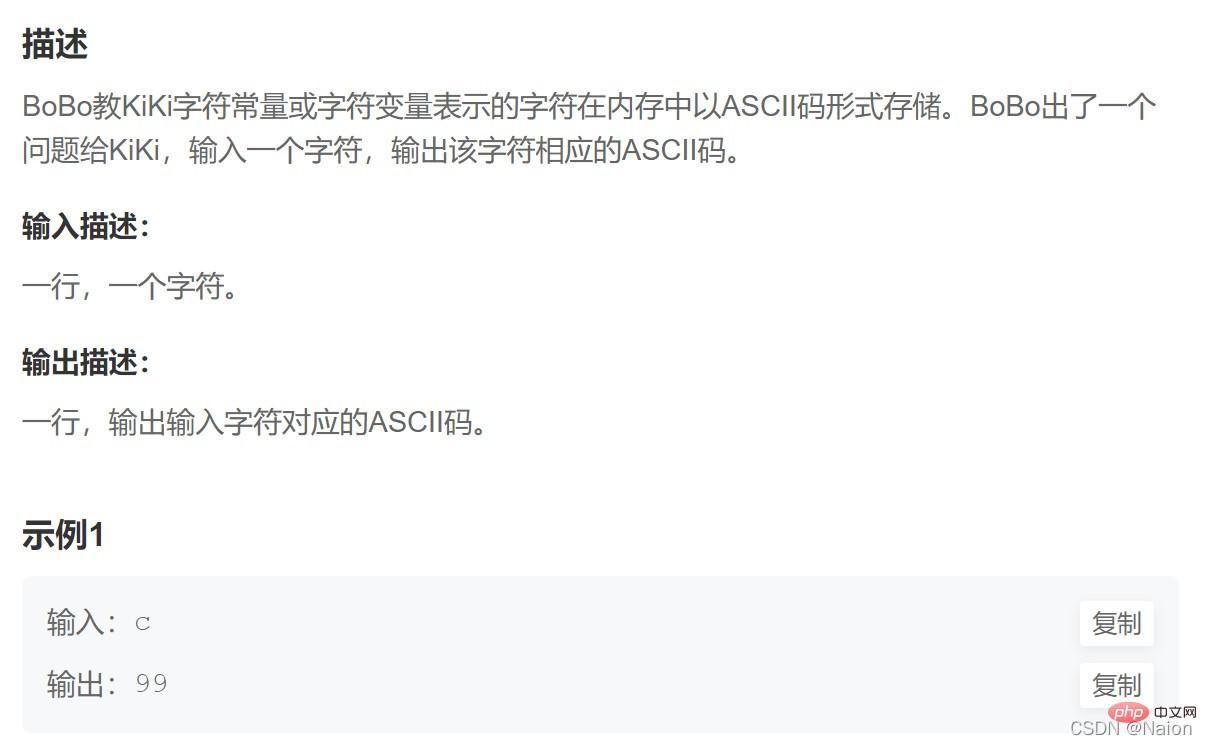
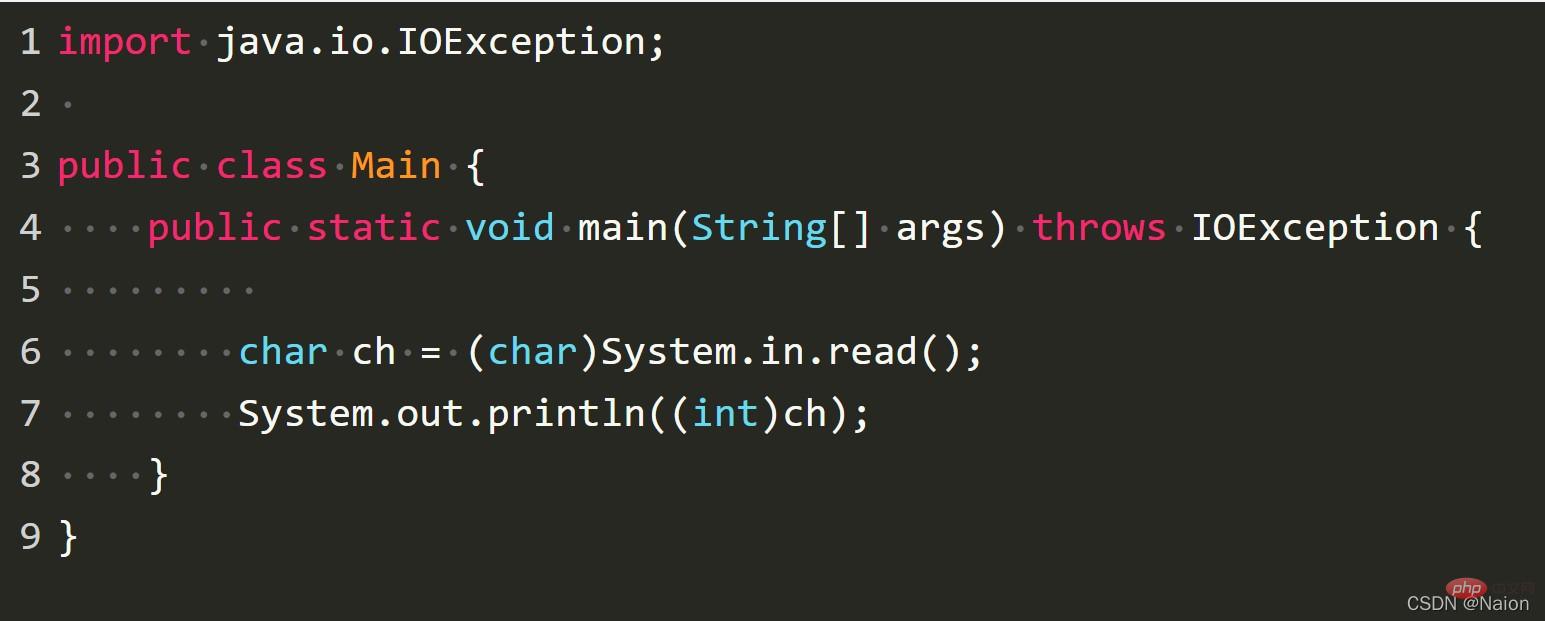
#
}
}
說明:需要搭配IOException異常來使用。 <1>中,System.in是從標準輸入流(最常見的是鍵盤)輸入,rand()方法是從這個流裡面讀取輸入的內容。 <1>的輸入結果是int型的,需要強制轉換成char型的。
1.2 範例說明
2、int型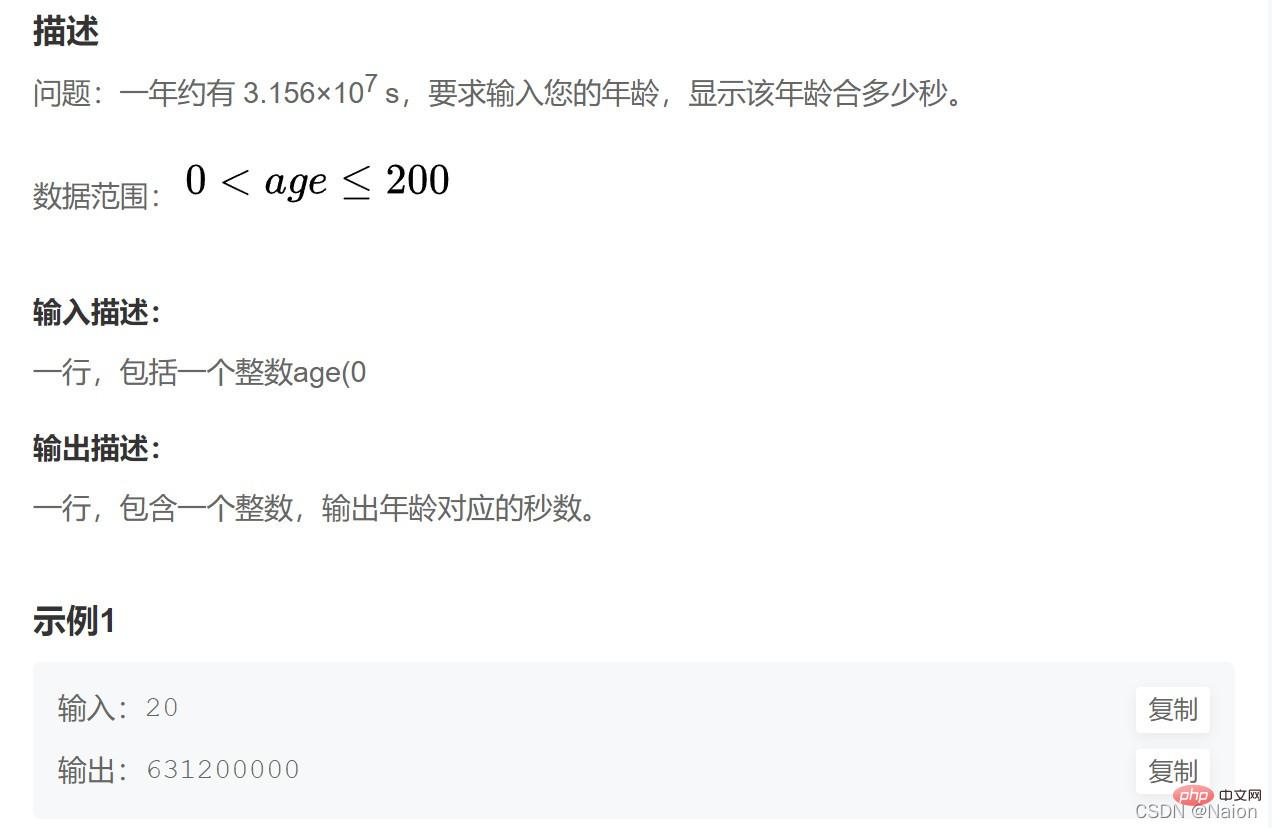
 這裡指的是每一行只有一個int型格式的輸入的情況。例如,每一行只輸入一個整型的情況。
這裡指的是每一行只有一個int型格式的輸入的情況。例如,每一行只輸入一個整型的情況。
public static void main(String[] args) {#
Scanner scan = new Scanner(System.in);int num = scan.nextInt(); # #
備註:需要為Long num,否者num很大時,結果不準確。 ########################2.1 有空格的int格式輸入 :###### 類似 23 34這樣的格式。兩個數字之間帶了空格,這時候,單用int輸入是解決不了問題的,當然,你可以連續使用兩個scan.nextInt()來進行輸入。但是,我們還可以這個時候,需要換個角度。我們將23 34整體看成一個字串,然後在空格處分割,分成23和34兩個字串,在將這兩個字串轉換成整數就可以了。關於split()的方法請查看官方的說明手冊。 #########import ###java.util.Scanner###;######public class Main {###### public static void main(String[] args) {# #####
# 1.2 舉例說明
Scanner scan = new Scanner(System.in);
String[] str = scan.nextLine().split("[ ]");///幾塊,就有幾塊字元,就有幾塊字元串數組,這裡有兩個
int a = Integer.parseInt(str[0]);
int b = Integer.parseInt(str[1]);//等等等...
System.out.println(a " " b);
}
}
2.2 舉例說明


3.1 複雜int格式的輸入
類似輸入a=3,b=2這樣的,方法和2.1中所說明的情況是一樣的。這裡我們直接上例題。
3.2 舉例說明
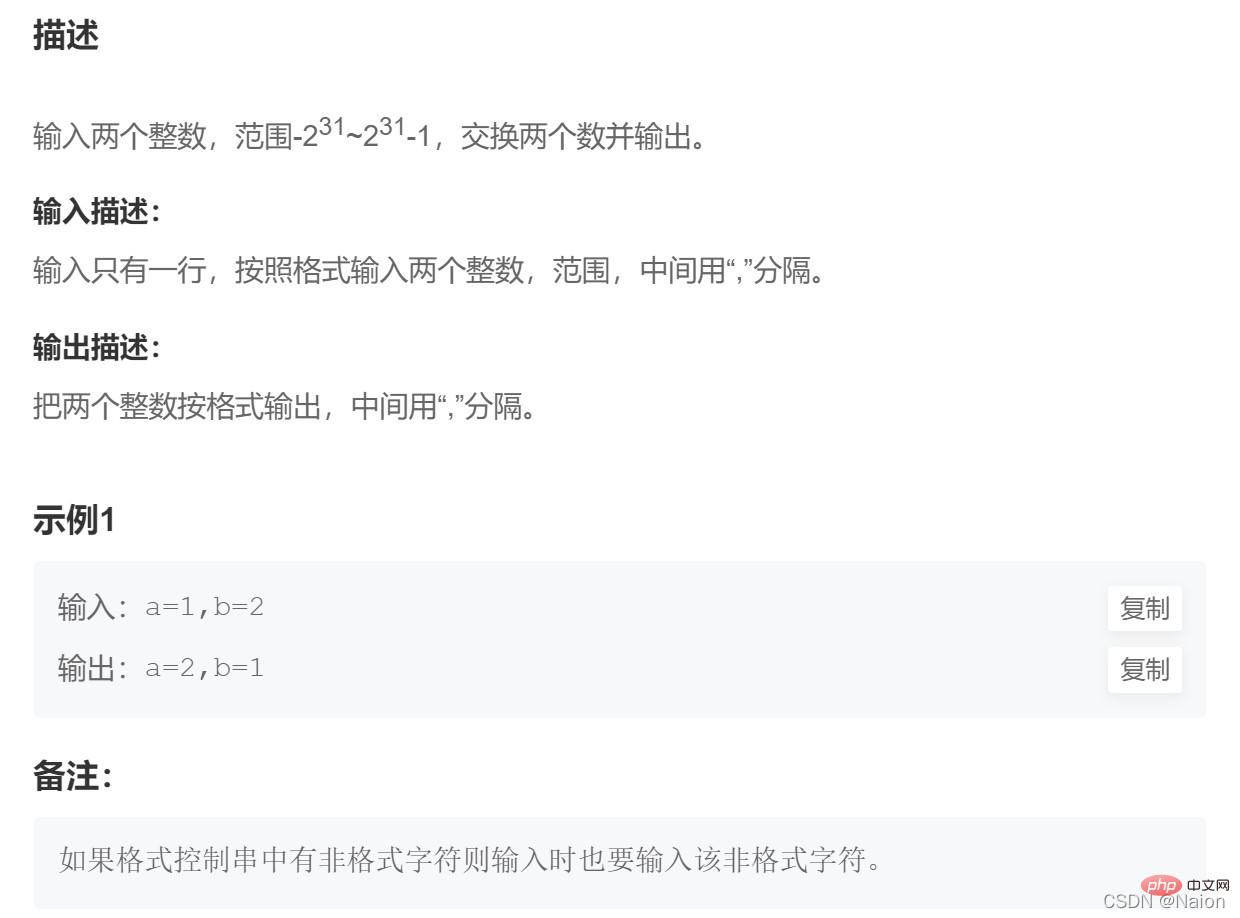
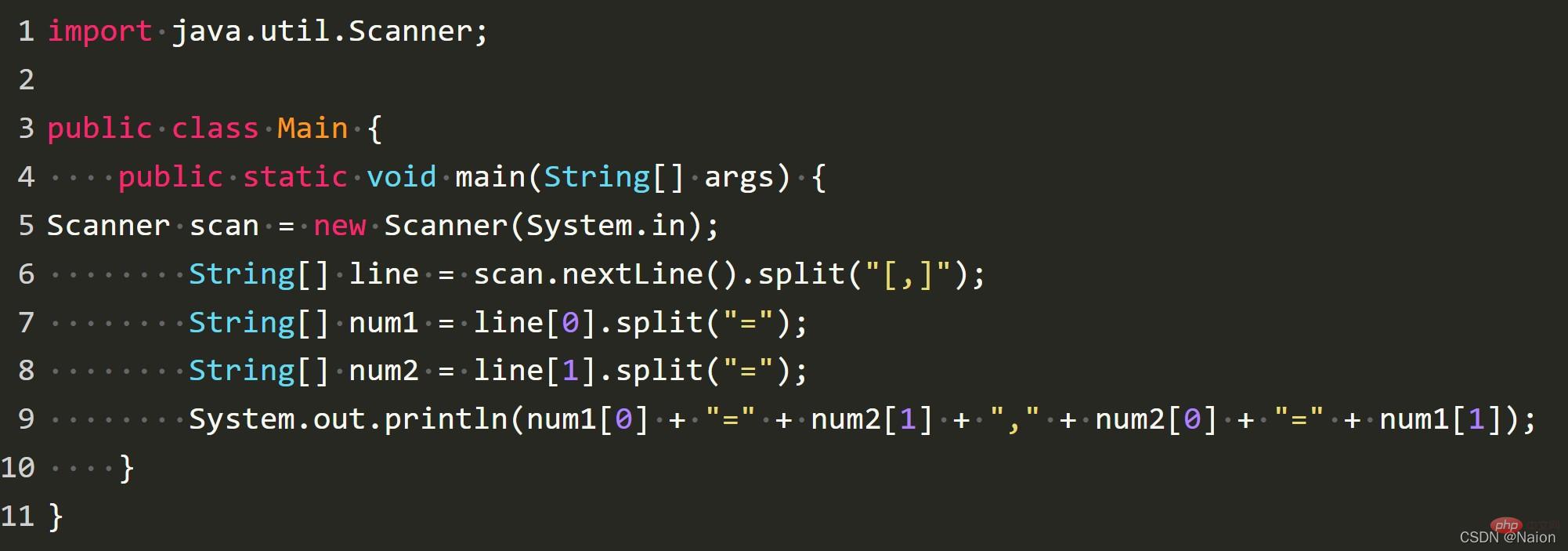
#long型別和int型別的輸入類似,不再累述。
3、double型
在Java中,應該較多的使用double型,而不是float型。
浮點型的主要是它的格式化輸出,例如保留兩位小數這樣的格式。在Java中,有類似C語言那樣的printf方法,我們也可以使用String中的format()方法來實作。
1.1 double保留兩位格式輸出
import java.util.Scanner;
public class Main { public static void main(String[] args) { Scanner scan = new Scanner(System.in); double num = scan.nextDouble(); String a = String.format("%.2f", num); System.out.println(a); } }登入後複製//printf格式輸出:
// System.out.printf("/", num);
1.2 範例說明
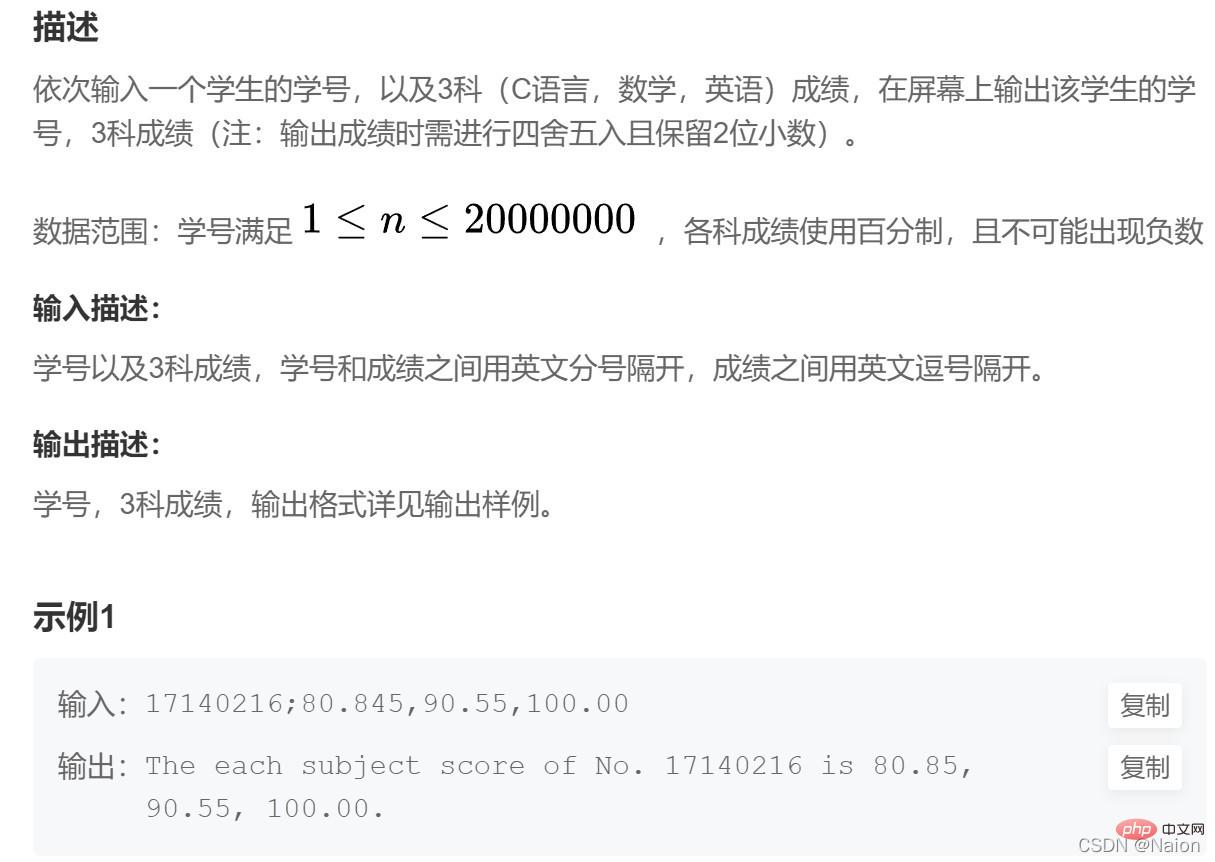
import java.util.Scanner;
public class Main {
public static void main(String[] args) {
Scanner scan = new Scanner(System.in);
String str = scan.nextLine();
String[] num = str.split("[;,]");
String a = String.format("%.2f", Double.parseDouble((num[1])));
String b = String.format("%.2f", Double.parseDouble((num[2])));
String c = String.format("%.2f", Double.parseDouble((num[3])));
System.out.println("The each subject score of No. " + num[0] + " is " + a + ", " + b + ", " + c + ".");
}
}4,多次輸入
1.1 輸入格式
在C語言中,循環多次輸入有兩種較簡單的方式:
while(scanf("%d", &n) != EOF)
## 在Java中,也有簡單的方式:while(~scanf("%d", &n) )
#while(scan.hasNext())1.2 範例說明
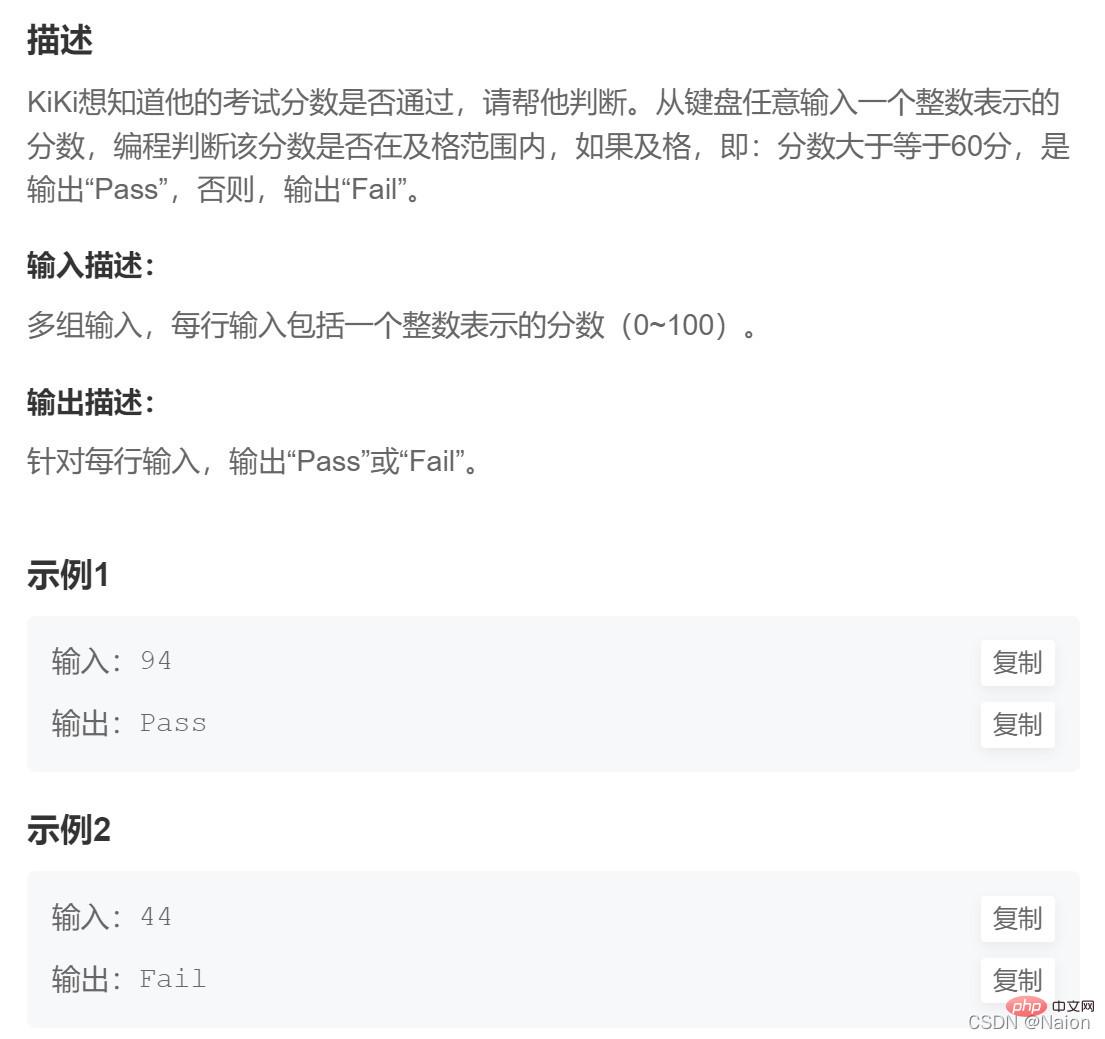

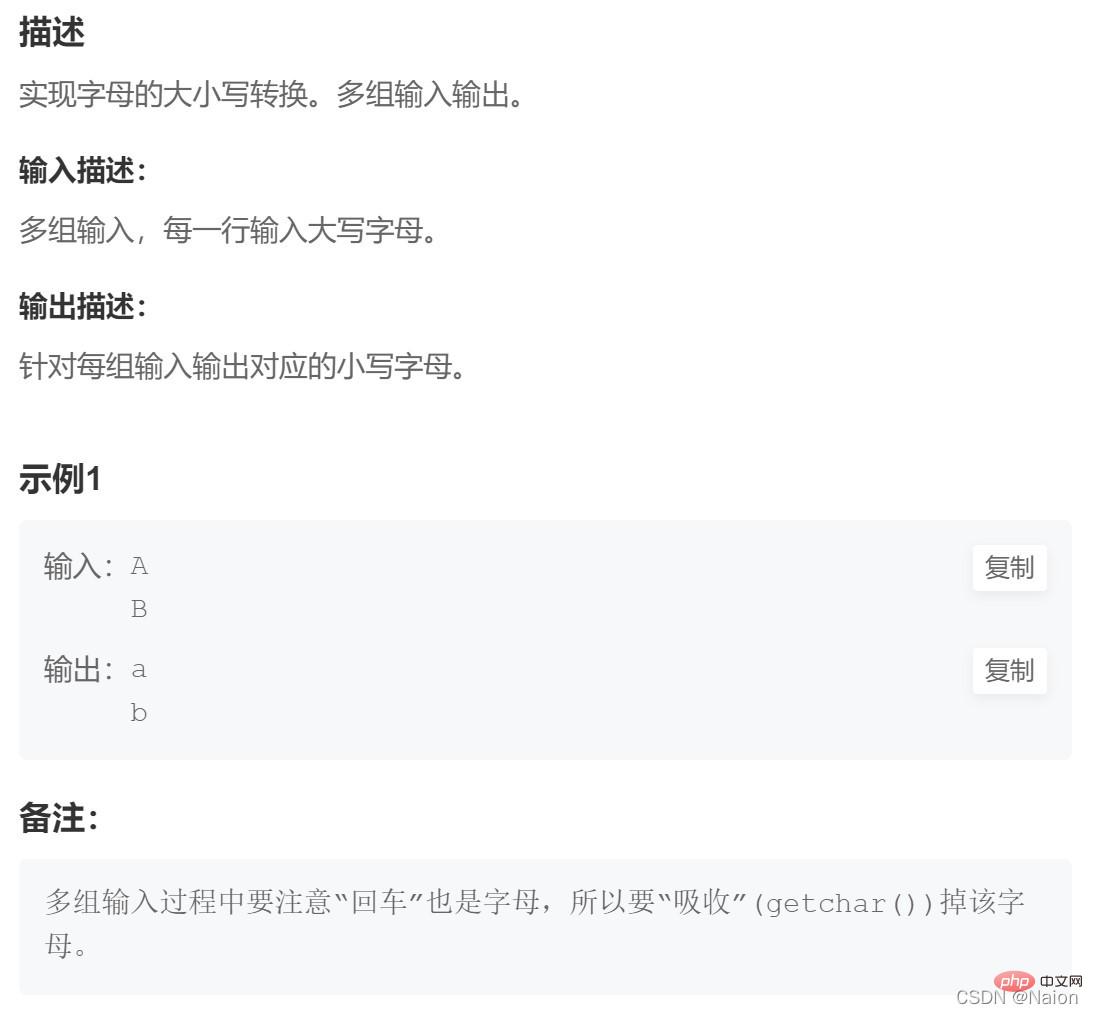
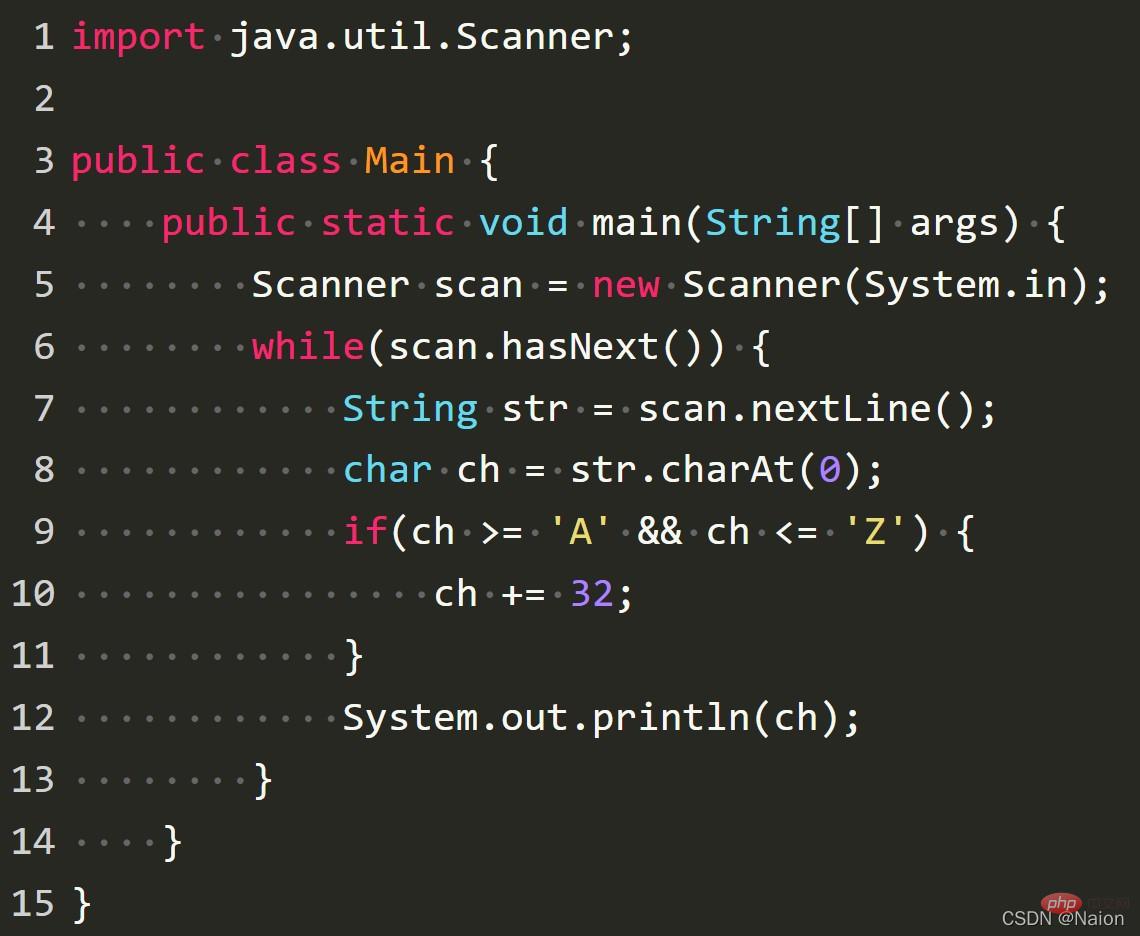 5、陣列
5、陣列
輸入和C語言中相似的。不過,要注意的是字串這樣的輸入,在C語言中,它是指標類型,在Java中,有它專屬的字串類型,不能像C語言一樣,沒有學指標之前,循環輸入每一個字符組成字串。
1.1 陣列輸入格式:
import java.util.Scanner;#2.1 陣列轉換成字串public class Main { public static void main(String[] args) { Scanner scan = new Scanner(System.in); int[] arr = new int[3];//输入3个 for(int i = 0; i < arr.length; i++) { arr[i] = scan.nextInt(); } for(int i = 0; i < arr.length; i++) { System.out.print(arr[i] + " "); } } }登入後複製
使用Arrays中的toString()方法即可。
import java.util.Scanner;import java.util.Arrays;
輸入1,2,3 結果你將會看見[1,2,3]。有時候OJ題的格式是1 2 3。 [1,2,3]這樣的格式也能通過。public class Main { public static void main(String[] args) { Scanner scan = new Scanner(System.in); int[] arr = new int[3];//输入3个 for(int i = 0; i < arr.length; i++) { arr[i] = scan.nextInt(); } System.out.println(Arrays.toString(arr)); } }登入後複製
6、字串
由於大多數輸入轉為了字串型別。因此,對於字串,需要進行轉換的操作比較多,例如分割後的字串轉換成整數,浮點型,陣列等。
1.1 字串轉換成整數型,浮點型(以整數型為例)
int a =Integer.parseInt(str[0] );//假設分割後str[0]是字元'1'
1.2 整數型,浮點型轉換成字串
##int num = 10 ;
// 方法1String str1 = num "";//「」表示空串,不同於Java中的null// 方法2String str2 = String.valueOf(num);2.1 字串轉換成字元陣列
import java.util.Scanner;
#import java.util.Arrays;public class Main {#public static void main(String[] args) {
Scanner scan = new Scanner(System.in);
String str = scan.nextLine();
char[] arr = str.toCharArray();
for (int i = 0; i < arr.length; i++) {
System.out.print(arr[i] + " ");
}
}
}
2.2 字符数组转换成字符串
// 方法1
new String(arr);
//方法2
String.copyValueOf(arr);
3 举例说明
描述:写一个函数,输入一个字符串,实现字符串的逆置。代码如下:
import java.util.Scanner;
public class Main {
public static String my_reverse(String str) {
int left = 0;
int right = str.length() - 1;
char[] arr = str.toCharArray();
while(left < right) {
char tmp = 0;
tmp = arr[left];
arr[left] = arr[right];
arr[right] = tmp;
left++;
right--;
}
return new String(arr);
}
public static void main(String[] args) {
Scanner scan = new Scanner(System.in);
String str = scan.next();
String ret = my_reverse(str);
System.out.println(ret);
}
}结果如下:
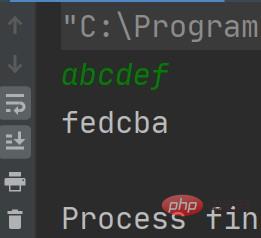
7、快速输入
用Scanner进行输入是比较慢的,在这里介绍一个新的输入输出的函数。它们相比起来,优点是速度比较快,缺点可能就是太长了,打字很费劲。
import java.io.*;
//省略了Main
public static void main(String[] args) throws IOException {
BufferedReader bf = new BufferedReader(new InputStreamReader(System.in));
int a = Integer.parseInt(bf.readLine());
System.out.println(a);
double b = Double.parseDouble(bf.readLine());
System.out.println(b);
char c = bf.readLine().charAt(0);
System.out.println(c);
char d = (char)bf.read();//都可以,但是这个不能和多组输入连用,原因是它保留了换行。
System.out.println(d);
System.out.println("------");
String str = null;
//多组输入
while((str = bf.readLine()) != null) {
char ch = str.charAt(0);//其他的类似
System.out.println(ch);
}
}推荐学习:《java学习教程》
以上是一起聊聊Java常用資料型別的輸入輸出的詳細內容。更多資訊請關注PHP中文網其他相關文章!

熱AI工具

Undresser.AI Undress
人工智慧驅動的應用程序,用於創建逼真的裸體照片

AI Clothes Remover
用於從照片中去除衣服的線上人工智慧工具。

Undress AI Tool
免費脫衣圖片

Clothoff.io
AI脫衣器

Video Face Swap
使用我們完全免費的人工智慧換臉工具,輕鬆在任何影片中換臉!

熱門文章

熱工具

記事本++7.3.1
好用且免費的程式碼編輯器

SublimeText3漢化版
中文版,非常好用

禪工作室 13.0.1
強大的PHP整合開發環境

Dreamweaver CS6
視覺化網頁開發工具

SublimeText3 Mac版
神級程式碼編輯軟體(SublimeText3)
 突破或從Java 8流返回?
Feb 07, 2025 pm 12:09 PM
突破或從Java 8流返回?
Feb 07, 2025 pm 12:09 PM
Java 8引入了Stream API,提供了一種強大且表達力豐富的處理數據集合的方式。然而,使用Stream時,一個常見問題是:如何從forEach操作中中斷或返回? 傳統循環允許提前中斷或返回,但Stream的forEach方法並不直接支持這種方式。本文將解釋原因,並探討在Stream處理系統中實現提前終止的替代方法。 延伸閱讀: Java Stream API改進 理解Stream forEach forEach方法是一個終端操作,它對Stream中的每個元素執行一個操作。它的設計意圖是處
 PHP:網絡開發的關鍵語言
Apr 13, 2025 am 12:08 AM
PHP:網絡開發的關鍵語言
Apr 13, 2025 am 12:08 AM
PHP是一種廣泛應用於服務器端的腳本語言,特別適合web開發。 1.PHP可以嵌入HTML,處理HTTP請求和響應,支持多種數據庫。 2.PHP用於生成動態網頁內容,處理表單數據,訪問數據庫等,具有強大的社區支持和開源資源。 3.PHP是解釋型語言,執行過程包括詞法分析、語法分析、編譯和執行。 4.PHP可以與MySQL結合用於用戶註冊系統等高級應用。 5.調試PHP時,可使用error_reporting()和var_dump()等函數。 6.優化PHP代碼可通過緩存機制、優化數據庫查詢和使用內置函數。 7
 PHP與Python:了解差異
Apr 11, 2025 am 12:15 AM
PHP與Python:了解差異
Apr 11, 2025 am 12:15 AM
PHP和Python各有優勢,選擇應基於項目需求。 1.PHP適合web開發,語法簡單,執行效率高。 2.Python適用於數據科學和機器學習,語法簡潔,庫豐富。
 PHP與其他語言:比較
Apr 13, 2025 am 12:19 AM
PHP與其他語言:比較
Apr 13, 2025 am 12:19 AM
PHP適合web開發,特別是在快速開發和處理動態內容方面表現出色,但不擅長數據科學和企業級應用。與Python相比,PHP在web開發中更具優勢,但在數據科學領域不如Python;與Java相比,PHP在企業級應用中表現較差,但在web開發中更靈活;與JavaScript相比,PHP在後端開發中更簡潔,但在前端開發中不如JavaScript。
 Java程序查找膠囊的體積
Feb 07, 2025 am 11:37 AM
Java程序查找膠囊的體積
Feb 07, 2025 am 11:37 AM
膠囊是一種三維幾何圖形,由一個圓柱體和兩端各一個半球體組成。膠囊的體積可以通過將圓柱體的體積和兩端半球體的體積相加來計算。本教程將討論如何使用不同的方法在Java中計算給定膠囊的體積。 膠囊體積公式 膠囊體積的公式如下: 膠囊體積 = 圓柱體體積 兩個半球體體積 其中, r: 半球體的半徑。 h: 圓柱體的高度(不包括半球體)。 例子 1 輸入 半徑 = 5 單位 高度 = 10 單位 輸出 體積 = 1570.8 立方單位 解釋 使用公式計算體積: 體積 = π × r2 × h (4
 PHP與Python:核心功能
Apr 13, 2025 am 12:16 AM
PHP與Python:核心功能
Apr 13, 2025 am 12:16 AM
PHP和Python各有優勢,適合不同場景。 1.PHP適用於web開發,提供內置web服務器和豐富函數庫。 2.Python適合數據科學和機器學習,語法簡潔且有強大標準庫。選擇時應根據項目需求決定。
 創造未來:零基礎的 Java 編程
Oct 13, 2024 pm 01:32 PM
創造未來:零基礎的 Java 編程
Oct 13, 2024 pm 01:32 PM
Java是熱門程式語言,適合初學者和經驗豐富的開發者學習。本教學從基礎概念出發,逐步深入解說進階主題。安裝Java開發工具包後,可透過建立簡單的「Hello,World!」程式來實踐程式設計。理解程式碼後,使用命令提示字元編譯並執行程序,控制台上將輸出「Hello,World!」。學習Java開啟了程式設計之旅,隨著掌握程度加深,可創建更複雜的應用程式。
 PHP:許多網站的基礎
Apr 13, 2025 am 12:07 AM
PHP:許多網站的基礎
Apr 13, 2025 am 12:07 AM
PHP成為許多網站首選技術棧的原因包括其易用性、強大社區支持和廣泛應用。 1)易於學習和使用,適合初學者。 2)擁有龐大的開發者社區,資源豐富。 3)廣泛應用於WordPress、Drupal等平台。 4)與Web服務器緊密集成,簡化開發部署。






